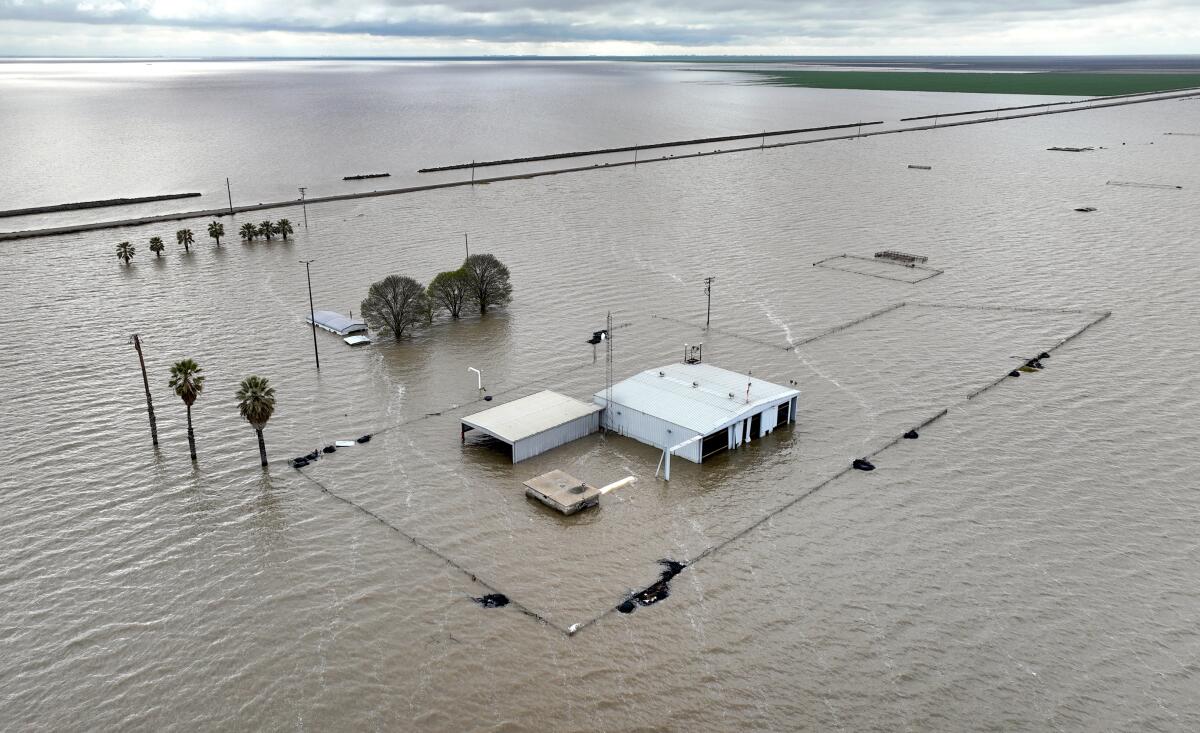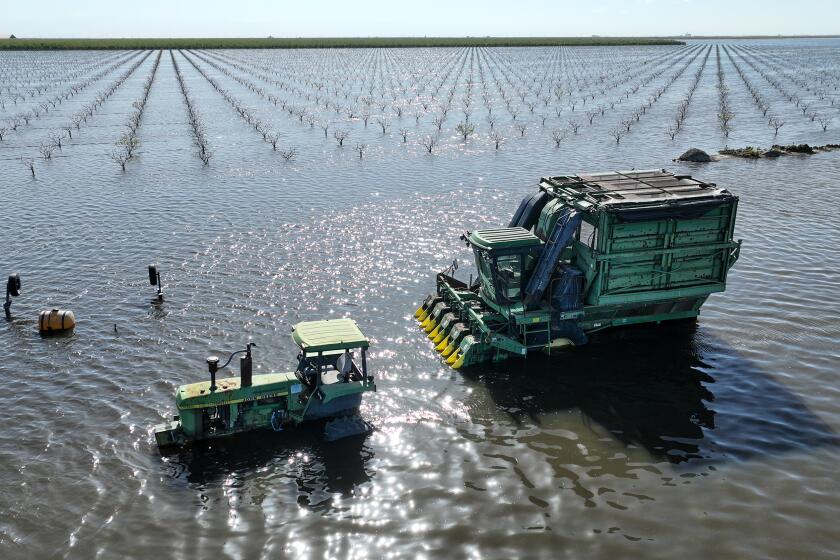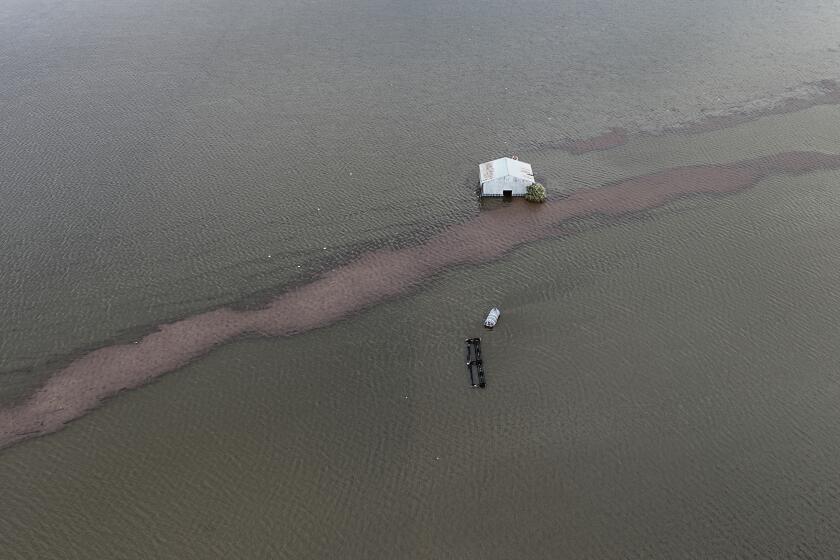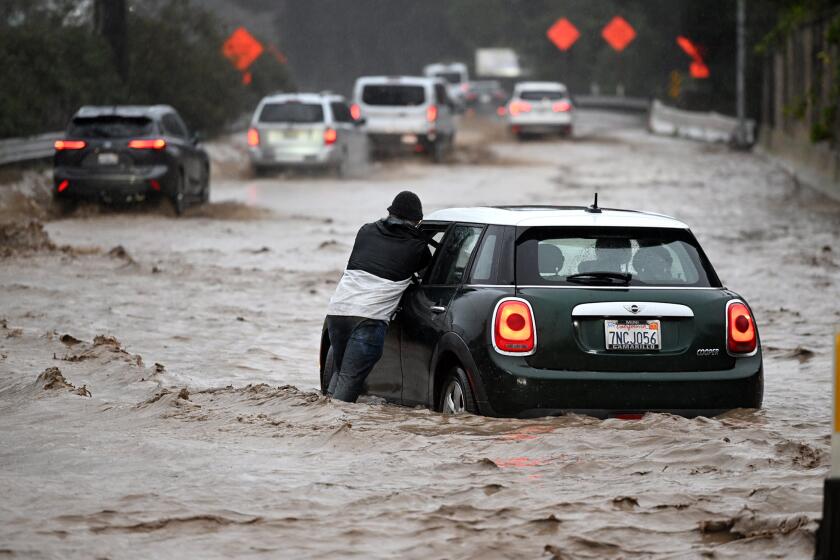Risk of ‘catastrophic flooding’ has diminished in Tulare Lake Basin, officials say

- Share via
The risk of catastrophic flooding in the Tulare Lake Basin has diminished as cool temperatures have predominated this spring, flattening the melt curve of the Sierra’s epic snowpack, state officials said Monday.
We are “not forecasting nearly as severe of damage as perhaps we were looking at several weeks ago,” Brian Ferguson, deputy director of crisis communications for the California Governor’s Office of Emergency Services, said at a news conference Monday. “However, we want to strongly emphasize that we are not out of the woods by any stretch of the imagination.”
Just a few weeks ago, officials worried that floodwaters from the melting Sierra Nevada snowpack would surge down the Tule, Kings, Kaweah and Kern rivers and topple berms, breach levees and inundate towns such as Corcoran and Stratford.
They now say their most conservative models don’t anticipate the lake exceeding a height of 184.1 feet above sea level — well below the 192 feet of newly reinforced levee protecting Corcoran, and roughly 2 feet lower than the forecast they delivered on April 21.
The only thing preventing floodwaters from inundating the city of Corcoran is an aging, 14-mile-long wall of dirt. Can it hold?
Indeed, Mehdi Mizani, the Department of Water Resources’ lead engineer on the Tulare Lake Basin, said the latest models suggest water levels will top out at around 181.1 feet on May 31, flooding approximately 620,000 acre-feet.
As of May 8, 103,000 acres of land in Tulare Lake were flooded. Water managers anticipate that number will grow over the next few weeks, and that a total of 117,000 to 132,000 acres could be submerged.
In 1983, one of the last few times the lake flooded, roughly 1 million acre-feet inundated roughly 85,000 acres.
Mizani said the state’s models incorporate the combined effects of weather, reservoir releases, agricultural demands and evaporation, although they don’t consider the reliability or strength of levees — which could impact the extent of flooding if they were to fail.
And the modeling process is “iterative,” he said. He and his team are “continuously working on refinements for the models, whether it’s just calibrating the models themselves or better understanding local operations to make sure that we’re capturing those correctly.”
Los Angeles County sends half a million tons of sewage sludge to Tulare Lake every year. Will it contaminate rising floodwaters?
UCLA climate scientist Daniel Swain agreed the cool spring thus far has helped alleviate flooding concerns.
“We’ve gotten relatively lucky so far,” Swain said during a briefing Monday. “We’ve threaded that needle — there’s been a lot of water coming downhill — but it has not all come downhill at once.”
However, the threat of the “Big Melt” remains cause for concern as much of the deepest snowpack in the southern Sierra Nevada has yet to melt.
“There is still a huge amount of water up there, and I think folks may be forgetting this because at low to middle elevations, the snow is largely gone,” Swain said.
“But at high elevations, where the vast majority of that actual snow water equivalent is, there’s still huge snowpacks — they’re still clearing roads in the High Sierra right now that have 20 to 30 feet of snow on them” at 8,000 to 10,000 feet.
Temperatures are beginning to heat up, he said, and some areas along the Merced River in Yosemite National Park are under flood watches and warnings as high flows are expected in the next few days.
But the main area of concern remains the Tulare Lake Basin, he said, which has no outlet and is still filled with deep and stagnant water from this year’s winter storms. Though a warm atmospheric river event or a prolonged heat wave could produce major flooding in the area, even gradual snowmelt threatens to make the current inundation worse.
A strong El Niño could augur yet another wet winter for California, as well as drive the global average temperature to a record high, experts say.
“There’s still major concern about Corcoran and some of these towns that are literally within this basin,” Swain said. “Agricultural land in that area is going to be flooded for months, and there’s still significant risk to populated areas in parts of the San Joaquin Valley for the next few weeks at least, and probably for the next couple of months.”
The state is stockpiling sandbags and other emergency equipment should the weather change, Ferguson said.
“While I think perhaps the most serious risk may have been averted, we don’t know what we don’t know,” Ferguson said, listing the many variables that could influence the speed, strength and amount of water flowing through the rivers.
“So while you know I think perhaps the most serious risk may have been averted, we don’t know what we don’t know yet in terms of how fast the water comes down the mountain, what levee may have squirrels in it that we’re not aware of, or a million other things that we don’t necessarily control as human beings,” he said.
“And so, while we are looking far, far better than we have in the past, we just want to emphasize that the public in these communities should continue to be aware of the challenges that lie ahead and that we will continue to be in this situation for at least through the month of July.”









